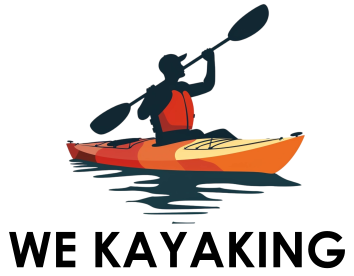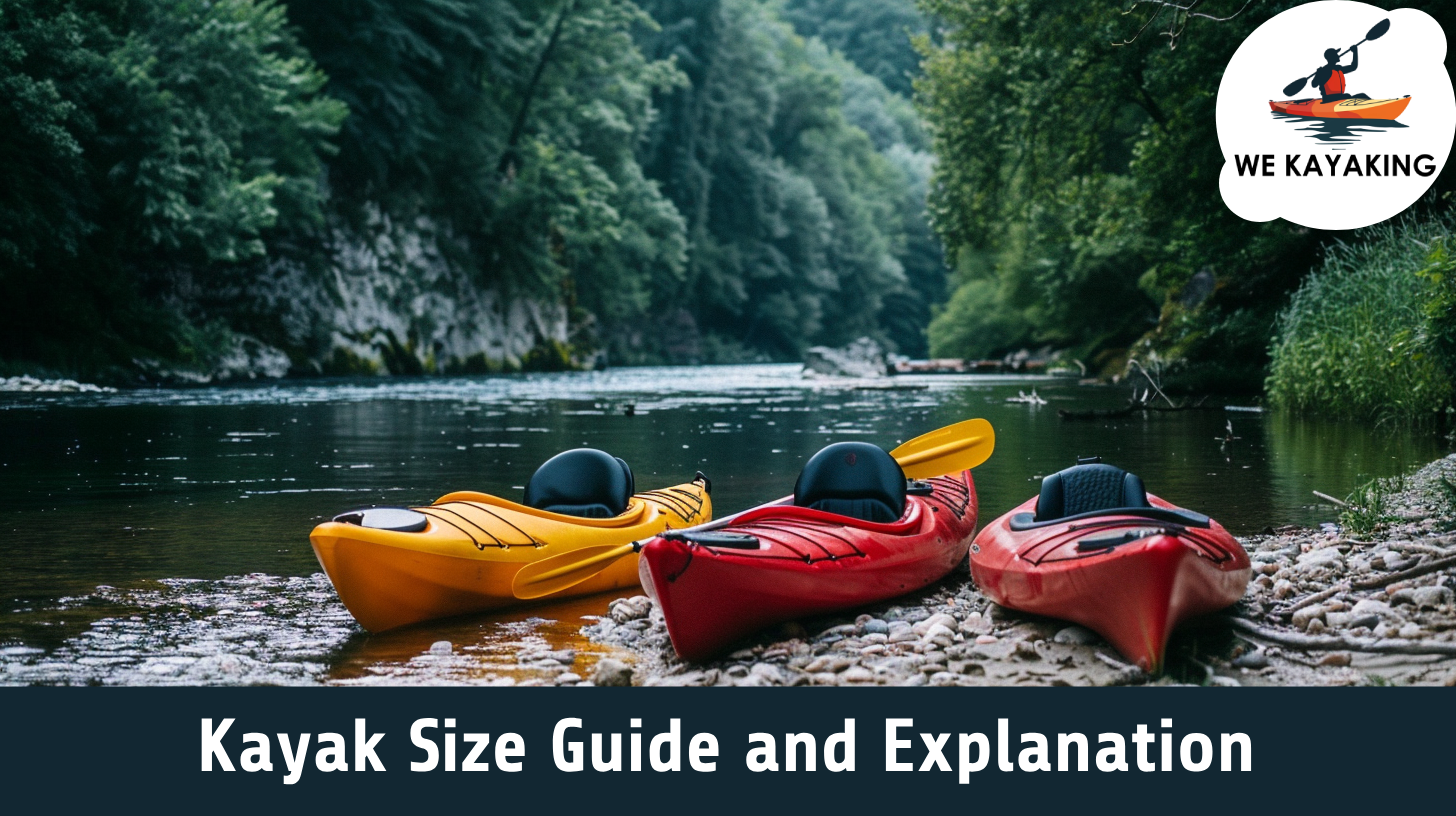
Kayak Size Guide and Explanation
The kayak’s size significantly influences its performance, with longer kayaks being faster and wider ones being more stable. Different types are suited for varying skill levels and purposes: recreational, day touring, and touring kayaks.
Length and width should align with your paddling goals and physical dimensions. Weight capacity and kayak weight affect transport and handling. Lastly, personal fit and cockpit size dictate comfort, control, and protection from the elements. These factors, together, help understand and guide the selection of an appropriate kayak.
Table of Contents
What kayak sizes exist?
Kayak sizes vary greatly to suit various water conditions, activities, and paddler preferences. They range from long, narrow models for touring and speed to short, wide ones for recreational use. Each size offers distinct features in terms of stability, maneuverability, and speed.
The table below illustrates more about kayak sizes.
| Kayak
Type |
Size Category | Length | Width | Ideal Use | Stability | Speed |
| Sit-on-top | Small | 8-12 ft (2.4-3.7m) | 30-34 in (76-86 cm) | Casual paddling,
warm climates |
High | Low |
| Sit-inside | Small | 8-12 ft (2.4-3.7m) | 20-30 in (51-76 cm) | Protected waters, cooler weather | High | Low |
| Day Touring | Medium | 10-14 ft (3-4.2m) | 24-28 in (60-71 cm) | Day trips, skill-building | Moderate | Moderate |
| Sea (Touring) | Large | 16-18 ft (4.8-5.4 m) | 22-24 in (56-60 cm) | Long-distance, open water | Low | High |
| Whitewater | Small-Medium | 4-10 ft (1.2-3m) | 20-25 in (51-64 cm) | Rapids, trick paddling | Variable | High |
| Inflatable | Variable | 8-12 ft (2.4-3.7m) | 30-38 in (76-97 cm) | Leisure, travel | High | Low |
| Fishing | Medium-Large | 10-14 ft (3-4.3m) | 34-38 in (86-97 cm) | Fishing, stability for casting | Very High | Low |
| Tandem | Medium-Large | 10-15 ft (3-4.6m) | 30-36 in (76-91 cm) | Two-person paddling | High | Low |
What are the most common kayak sizes?
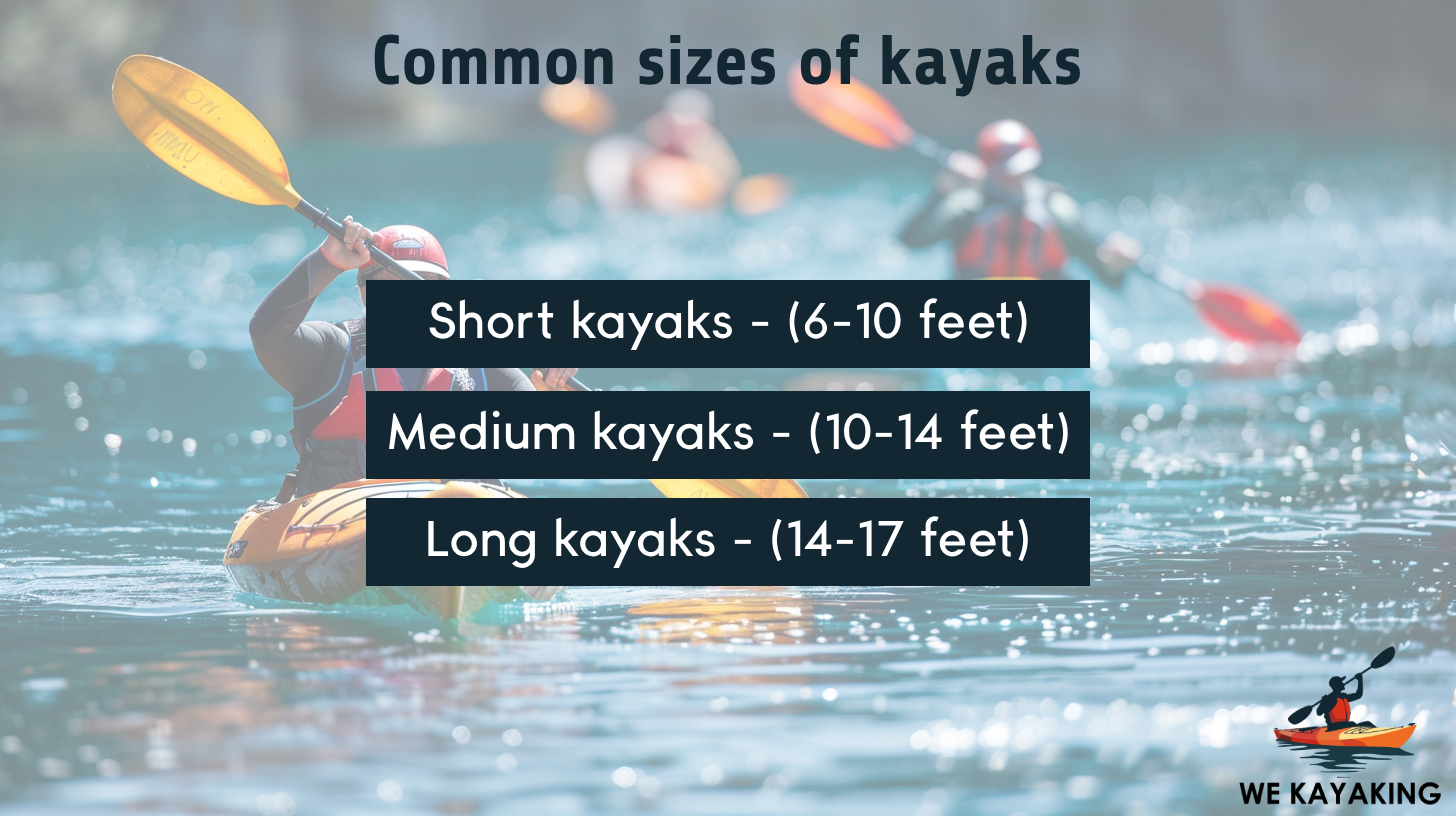 The most common kayak sizes range from about 6 feet to 17 feet in length. Shorter kayaks (6-10 feet) are more stable and maneuverable, making them suitable for recreational use and beginners.
The most common kayak sizes range from about 6 feet to 17 feet in length. Shorter kayaks (6-10 feet) are more stable and maneuverable, making them suitable for recreational use and beginners.
Medium-length kayaks (10-14 feet) offer a balance between stability and speed, making them popular for day touring. The longest kayaks (14-17 feet) are designed for speed and distance, making them ideal for touring and sea kayaking. The width also varies, affecting stability and speed, with wider kayaks being more stable and narrower ones being faster. These sizes accommodate different water types, paddler sizes, and activities.
How to choose the size of the kayak?
It is important to take into account the kayak’s intended uses in addition to its length and width when selecting a size. Longer kayaks provide better speed and straight-line tracking, making them ideal for longer distances and open water. They are suited for experienced kayakers interested in touring or sea kayaking. On the other hand, shorter kayaks are more maneuverable and are usually chosen for fishing, leisure use, or negotiating small channels.
The width of a kayak largely influences its stability - wider kayaks are more stable and are often recommended for beginners, while narrower kayaks are faster and used for competitive or long-distance paddling.
In addition to length and width, your body size and the kayak’s weight capacity are critical factors. Taller or larger individuals prefer longer and slightly wider kayaks for comfort and adequate space, whereas shorter or lighter individuals opt for smaller kayak models.
Consider the types of water you will navigate: calm lakes, flowing rivers, or open seas, as different environments require different kayak characteristics. Lastly, always try to test various kayaks for comfort and handling. Consulting with more experienced kayakers, reading reviews, and understanding the specifics of each kayak type will guide you to the best choice for your paddling adventures.
What size kayak for a 6’ person?
A size of 12-14 ft long and a 23-26 inches wide kayak is suitable for a 6ft person. Kayakers who are 6ft tall have an arm length of 70-76 inches therefore a paddle length of 6.9-7.2 feet is ideal for a 6ft person to have a more comfortable experience kayaking. These dimensions will vary based on specific kayaking activities, such as recreational, touring or whitewater adventures, and personal handling preferences. It’s also essential to test different models for the best personal fit.
What size kayak for a 5’ 8" person?
A size of 11-13 ft long and a 21-24 inches wide kayak is a suitable size for a 5ft 8 person. Kayakers who are 5ft 8 tall have an arm length of 23-25 inches and a paddle length of 6.6-7 feet which is ideal for a 5ft 8 person to have a more comfortable experience kayaking.
What size kayak for a 4’ 5" person?
A size of 8-10 ft long and a 20-22 inches wide kayak is a suitable size for a 4ft 5 person. Kayakers who are 4ft 5 tall have an arm length of 15-17 inches and a paddle length of 5.1-5.5 feet which is ideal for a 4ft 5 person to have a more comfortable experience kayaking.
The recommended kayak sizes for people between 4'5" and 4'11" are similar because the smaller end of the kayak range has fewer options for shorter paddlers. These similar recommendations stem from the fact that these sizes offer shorter people the comfort, stability, and ease of handling they require for a comfortable kayaking experience.
What size kayak suits a 10-year-old?
The suitable size kayak for a 10-year-old ranges from 6 to 8 feet in length, with a width of 20-24 inches. Paddle length ranges from 4.9 to 5.2 feet, and arm lengths will correspond to their particular size ranging from 18-21 inches. These kayaks are safer and easier to handle because they are made for younger paddlers with similar stature and skill levels. It’s important to adjust these ranges based on the individual child’s height and arm length for optimal comfort and control.
What size kayak suits a 15-year-old?
The suitable size kayak for a 15-year-old ranges from 8 to 13 feet in length, with a width of 22-25 inches. Paddle length ranges from 6.6 to 6.9 feet, and arm lengths will correspond to their particular size ranging from 21-23 inches.
What is the difference between a 10ft vs 12ft kayak?
A 10ft kayak is more maneuverable, lighter, and easier to handle, making it suitable for beginners or those using it in small water bodies like creeks and ponds. It usually has less storage and is slower, but a 12-foot kayak, on the other hand, offers better tracking, more speed, and stability in choppy waters, making it suitable for longer trips and varied water conditions. It provides more storage space and comfort for longer journeys than what a 10ft kayak offers, but is heavier and less convenient to transport and store.
What is the difference between an 8ft vs 10ft kayak?
An eight-foot kayak is also useful for whitewater applications but a ten-foot kayak is used in recreational activities. The speed of a ten-foot kayak is also higher than an eight-foot kayak, since it is a larger body. An eight-foot kayak is great for kids and adults on the shorter side while a ten-foot kayak is suitable for larger persons. The ten-foot kayak also offers improved tracking over longer distances compared to the eight-foot model. A ten-foot kayak provides more storage and stability compared to an eight-foot kayak.
What size kayaks do professionals use?
Professional kayakers use kayaks tailored to their specific discipline. Sea kayakers often use longer boats (14-18 feet) for stability and speed, while whitewater professionals prefer shorter ones (6-9 feet) for maneuverability. Slalom racers use even shorter and more agile kayaks ranging from 11-13 feet. The size is chosen for optimal performance in their respective activities.
What kayak size is best for kids?
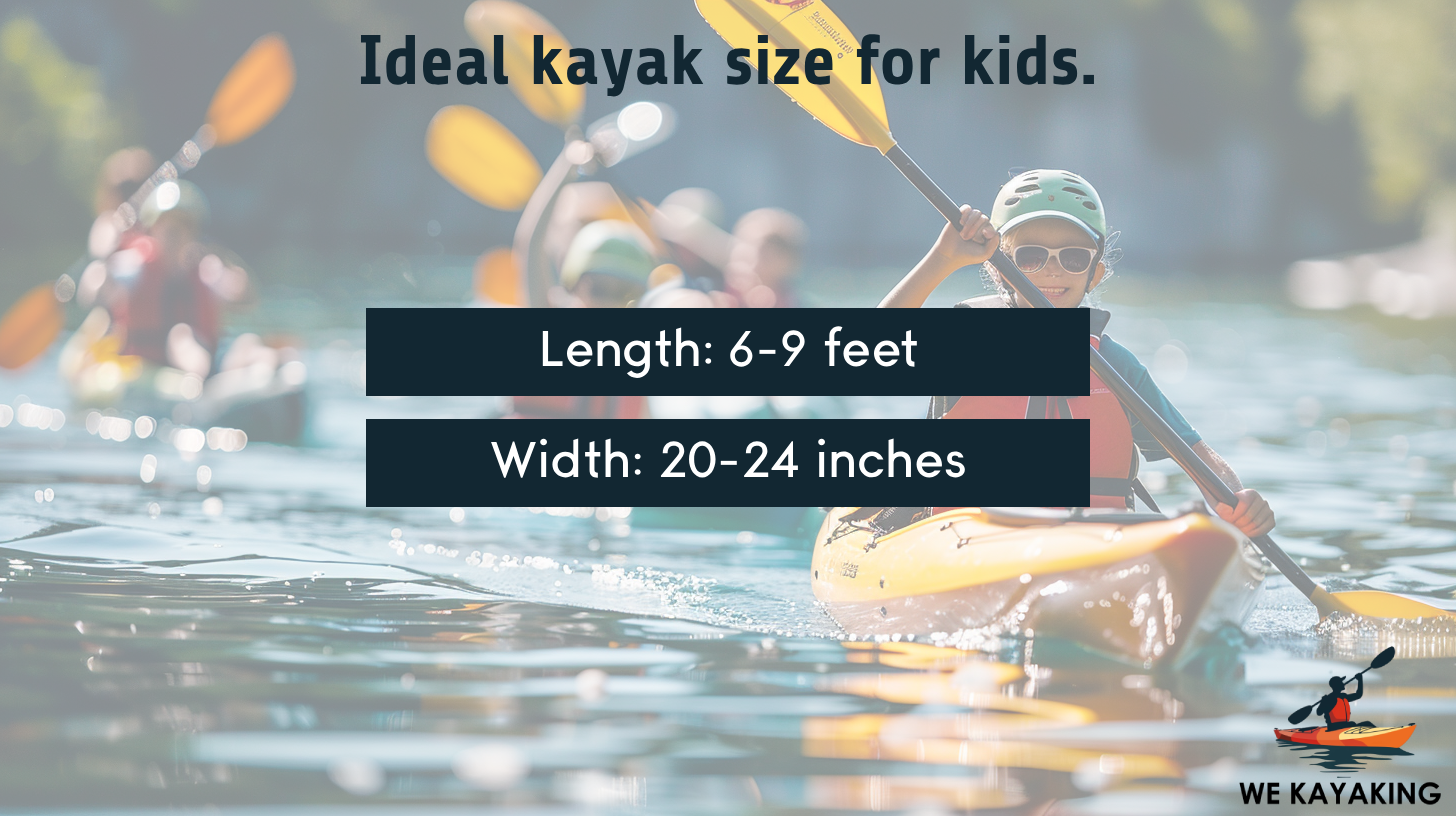 The best kayak size for kids is in the range of 6-9 feet in length and a width of 20-24 inches. This range ensures the kayak is stable enough to prevent tipping over easily, offering a safer experience. These kayaks are lighter, making them easier for children to handle both in and out of the water. The exact sizes will depend on the type of activity, their height, water condition and personal preference.
The best kayak size for kids is in the range of 6-9 feet in length and a width of 20-24 inches. This range ensures the kayak is stable enough to prevent tipping over easily, offering a safer experience. These kayaks are lighter, making them easier for children to handle both in and out of the water. The exact sizes will depend on the type of activity, their height, water condition and personal preference.
What kayak size is best for beginners?
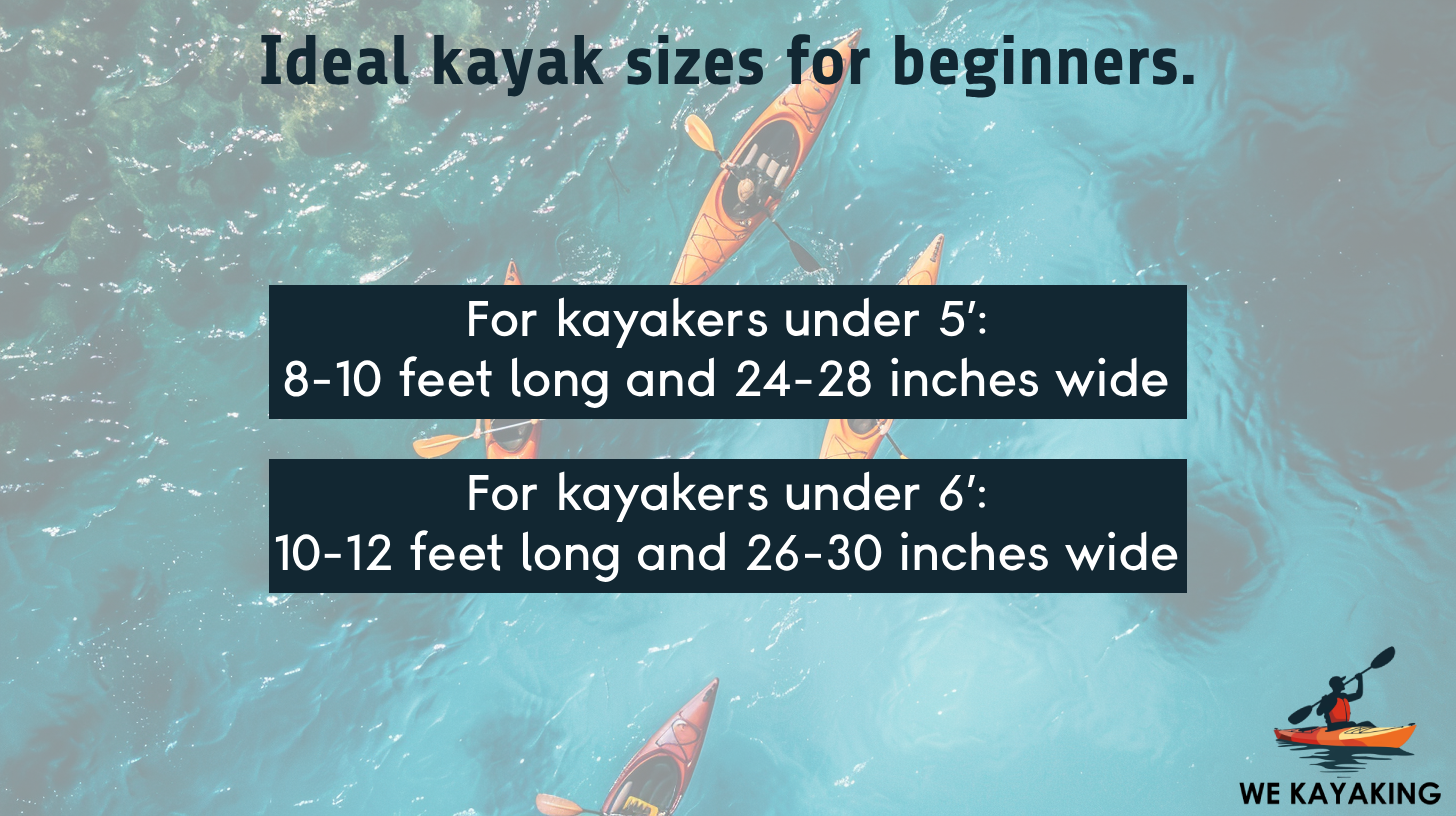 For beginners under 5’, kayaks around 8-10 feet long and 24-28 inches wide are suitable, offering stability and manageability. For those under 6’, kayaks from 10-12 feet long and 26-30 inches wide are recommended, providing balance and comfort as they learn. These dimensions offer a good balance of stability, ease of handling, and maneuverability, making them suitable for learning and gaining confidence in the water.
For beginners under 5’, kayaks around 8-10 feet long and 24-28 inches wide are suitable, offering stability and manageability. For those under 6’, kayaks from 10-12 feet long and 26-30 inches wide are recommended, providing balance and comfort as they learn. These dimensions offer a good balance of stability, ease of handling, and maneuverability, making them suitable for learning and gaining confidence in the water.
Is a bigger size kayak easier to control?
No, a bigger size kayak is not easy to control compared to a smaller kayak. Smaller kayaks are more agile and easier to control, especially in tight spaces. Bigger kayaks are better suited for stability and longer voyages. Greater tracking, or staying straight on course, is an advantage of larger kayaks, especially in open or choppy waters. Smaller kayaks are more maneuverable and handled more easily in tight spots or swiftly moving water.
Does a bigger size kayak hold more weight?
Yes, a bigger size kayak holds more weight. Larger kayaks have more volume, which increases their buoyancy and allows them to support more weight without compromising stability or performance. This means they accommodate heavier paddlers or more gear. Larger recreational kayaks hold between 250 to 350 pounds, while larger touring or sea kayaks hold between 350 to 550 pounds. Fishing kayaks are also designed to accommodate more weight and gear. They hold in the range of 400-550 pounds of weight.
Is a bigger size kayak easier to maneuver?
No, a bigger size kayak is challenging to maneuver. Larger kayaks, while more stable and better at tracking straight, are less agile and require more effort to turn and handle, especially in tight spaces or quick turns. Smaller kayaks are more maneuverable in most situations and most waters.
Are bigger kayaks more comfortable?
Yes, bigger kayaks are more comfortable. Bigger kayaks often provide a more comfortable seating area, better back support, and more room to adjust your position, which reduces fatigue and increases enjoyment, especially for taller individuals. They often have more room for the paddler, longer leg space, and more storage for gear, which contributes to a more comfortable experience, especially on longer journeys.
Is a larger kayak safer?
Yes, kayak safety is more profound in larger kayaks. Larger kayaks are safer as they offer more stability, especially in choppy waters. Larger kayaks offer more stability and safety in terms of reduced capsizing risks; safety of kayak also involves the ability to handle the kayak effectively. This is reassuring for beginners or those paddling in challenging conditions.
Are bigger kayaks more expensive?
Yes, bigger kayaks are more expensive. This is because of the increased materials and design complexity needed for larger sizes. The added length and width often mean more sophisticated construction and additional features, leading to higher costs.
Are bigger kayaks difficult to transport compared to smaller kayaks?
Yes, a larger kayak is more difficult to transport. Bigger kayaks are more difficult to transport because of their increased length and weight. Larger kayaks require more space for storage and transporting a kayak often necessitates additional equipment such as specialized roof racks or trailers. Maneuvering them around obstacles or through narrow spaces when off the water is also challenging due to their size and weight. This makes them more cumbersome to carry, load, and secure on a vehicle.
